DEMO Divertor Cassette and Plasma facing Unit in Vessel Loss-of-Coolant Accident
Abstract
:1. Introduction
2. Materials and Methods
2.1. DEMO Divertor In-Vessel Component and Heat-Transfer System Description
2.2. Accident Specification for the Considered Cases
- The tritium inventory is 2673 g-T assumed as 100% mobilizable in HTO form.
- The W dust amount is assumed as 1034 kg within VV for all in-vessel components as a mean value from what is reported in [24]. An additional 5 kg inventory is assumed to be created as a consequence of disruption following plasma shutdown in the accident sequence. All inventory is assumed as resuspended and 100% mobilizable.
- An assessment of a divertor ACP inventory of 3.5 kg was assumed in the analysis [23].
2.3. Simulation Models and Nodalization
- (i)
- An HTS loop serving 8 out of 16 DEMO sectors for the divertor cassette (24 cassettes out of 48), with a pressure at 3.5 MPa at the cassette inlet dropping down to 2.5 MPa at hot ring collector and to about 2.3 MPa at the HW outlet. The HTS includes one heat exchanger, one pump (1.48 MPa of pump head), one pressurizer, and one cold leg from pump to cold ring distributor, then splits into 24 distributor pipes up to the in-vessel components. The coolant is then collected from the the in-vessel components by means of 24 collecting pipes into the hot ring and led to the HX by means of the hot leg.
- (ii)
- The HTS loop for the divertor PFU (24 PFUs out of 48) has the same equipment and layout as the divertor cassette HTS, with the pump providing 1.82 MPa of head to compensate for pressure drops.
- (iii)
- Divertor cassette in-vessel components include:
- a.
- Two cassettes (the one involved in the PIE events and another corresponding with the PFU impacted by the disruption) are defined more in detail according to the scheme in (Figure 6). The cassette is modeled considering the cooling-water path across the cassette, entering a first CB-A volume (15% of cassette water volume), followed by liner and RP (accounting for 2 RP) volumes, and finally followed by a CB-B volume (accounting for the remaining 85% of the cassette volume).
- b.
- Twenty-two lumped cassettes (Figure 7) merging CB-A, CB-B, liner and RP volumes.
- (iv)
- Divertor target in-vessel components include:
- a.
- A more detailed nodalization was implemented for 2 PFU (Figure 6) representing the PFU involved in the PIE event, and the PFU impacted by the disruption, respectively. These 2 units are further composed by: an inlet CV feeding the cooling water to two separate CVs for the inner and outer vertical targets volumes respectively; a volume representing an inner vertical target; a volume representing an outer vertical target; and an outlet CV collecting water from the IVT and OVT. The target channels are merged into a unique volume equivalent to the sum of all channel volumes.
- b.
- Twenty-two PFU lumped units. A single CV has been defined accounting for both the inlet/outlet pipes and IVT/OVT channels equivalent volumes.
- (v)
- Tokamak systems: vacuum vessel and connected lower and upper port volumes; VVPSS-Ta and VVPSS volume partially filled in water and kept at a pressure of 9.5 103 Pa; confinement model for tokamak systems and building including cryostat, cryostat space, and galleries.
- (i)
- Cassette HS.
- a.
- The CBA volume has two Eurofer HSs, one in radiative contact with the OVT and one in between the CBA and CBB CV. These two HSs are in conductive contact with MELCOR user FUN1.
- b.
- The liner volume has two HS, one (W + Eurofer) receiving plasma loads and one (Eurofer) in radiative connection with the cassette HS (CB-B-top). These two HSs are also in mutual conductive contact by means of MELCOR FUN1.
- c.
- The RP (accounting for two RP) volume has two HS, one (W + Eurofer) receiving plasma loads and one (Eurofer) in radiative contact with the cassette HS (CB-B-top). These 2 HSs are also in mutual conductive contact with FUN1.
- d.
- The CB-B volume has 2 HSs, one in contact with IVT and one in radiative contact with the VV walls. These 2 HSs are also in mutual conductive contact with FUN1. Other than nuclear heating, during the plasma pulse, the liner and RP units are assumed to be under a heat flux respectively of 1.0 MW/m2 and 0.2 MW/m2 from plasma. Nuclear heating (NH) during the pulse and decay heat (DH) at shutdown data are reported in Table 2.
- (ii)
- PFU HS.
- a.
- The IVT considers 2 HSs representing vertical targets towards the plasma and cassette.
- b.
- OVT considers 2 HS representing vertical targets towards the plasma and the cassette.
- c.
- One HS has been defined to represent feeding pipe walls.
- (i)
- Two HSs representing PFU vertical targets towards the plasma and the cassette and one HS representing pipe walls are implemented
- (ii)
- One HS (CB-A_CB-B_PFU) is the Eurofer volume accounting for the cassette in radiative contact with the PFU vertical targets; one HS represents the liner and reflector plates (RP) (W + Eurofer) receiving the plasma load and one HS (CB-A_CB-B) in Eurofer volume accounts for the remaining part of the cassette.
- (i)
- One HS representing the FW and the breeding blanket (BB) is implemented with an initial temperature of 650 K. Decay heat (at shutdown) data are reported in Table 2. This HS is coupled radiatively with the VV walls using a FUN1 function.
- (ii)
- Three HSs representing the PFU, cassette, and liner/RP components from the second divertor PFU and cassette loops, respectively. These HSs are coupled radiatively to each other and to the VV walls using a FUN1 function, as shown in Figure 8.
- (iii)
- The VV has 2 HSs representing the walls and floor (the surface under the divertor). These HSs have no nuclear heating or decay heat models and have an external layer at a fixed temperature of 195 °C representing the tokamak decay heat removal system (DHRS).
- (iv)
- VV-upper port has a vertical-walls HS with external layer at a fixed temperature of 195 °C Other in-vessel components
- (v)
- VV-lower port has a vertical-walls HS and floor HS with an external layer at a fixed temperature of 195 °C
- (vi)
- The VVPSS and VVPSS-A are provided with an HS representing the lateral walls initially at room temperature.
3. Results and Discussion
4. Conclusions
Author Contributions
Funding
Conflicts of Interest
Nomenclature
| ACP | Activated Corrosion Products | |
| BB | Breeder Blanket | |
| BDBA | Beyond Design-Basis Accident | |
| CAS | Cassette | |
| CB | Cassette Body | |
| CV | Control Volume | |
| DBA | Design-Basis Accident | |
| DEC | Design Extension Conditions | |
| DEGB | Double-End Guillotine Break | |
| DIV/DV | Divertor | |
| ENV | Environment (Control Volume) | |
| FL | Flow Path Line | |
| FW | First Wall | |
| GAL-B3-B4 | Gallery at building levels 3–4 | |
| HS | Heat Structure | |
| HTS | Heat-Transfer System | |
| HX | Heat Exchanger | |
| IVT | Inner Vertical Target | |
| LOCA | Loss of Coolant Accident | |
| LP | Lower Port | |
| OVT | Outer Vertical Target | |
| PC | Port Cell | |
| PFC | Plasma-Facing Components | |
| PFU | Plasma-Facing Units | |
| PIE | Postulated Initiating Event | |
| SSC | Systems Structures and Components | |
| VDS | Venting Detritiation System. | |
| VV | Vacuum Vessel | |
| VV-LP | Vacuum Vessel | Lower Port |
| VV-PC | Vacuum Vessel | Plasma Chamber |
| VV-UP | Vacuum Vessel | Upper Port |
| VVPSS | Vacuum Vessel Pressure Suppression System |
References
- Federici, G.; Bachmann, C.; Barucca, L.; Baylard, C.; Biel, W.; Boccaccini, L.V.; Bustreo, C.; Ciattaglia, S.; Cismondi, F.; Corato, V. Overview of the DEMO staged design approach in Europe Nucl. Fusion 2019, 59, 066013. [Google Scholar] [CrossRef] [Green Version]
- Federici, G. Special Issue on European Programme towards DEMO: Outcome of the Pre-Conceptual Design Phase. Fusion Eng. Des. 2022, 178, 113103. [Google Scholar] [CrossRef]
- You, J.H.; Mazzone, G.; Visca, E.; Greuner, H.; Fursdon, M.; Addab, Y.; Bachmann, C.; Barrett, T.; Bonavolontà, U.; Böswirth, B.; et al. Divertor of the European DEMO: Engineering and technologies for power exhaust. Fusion Eng. Des. 2022, 175, 113010. [Google Scholar] [CrossRef]
- IAEA. Considerations on the Application of the IAEA Safety Requirements for the Design of Nuclear Power Plants; IAEA-TECDOC-1791; IAEA: Vienna, Austria, 2016. [Google Scholar]
- Merrill, B.J. Recent Updates to the MELCOR 1.8.2 Code for ITER Applications; Idaho National Laboratory: Idaho Falls, ID, USA, 2007; p. INL/EXT-07-12493. [Google Scholar]
- Merrill, B.J.; Humrickhouse, P.W. Masashi Shimada, Recent development and application of a new safety analysis code for fusion reactors. Fusion Eng. Des. 2016, 109–111, 970–974, ISSN 0920-3796. [Google Scholar] [CrossRef] [Green Version]
- Dongiovanni, D.N.; D’Onorio, M. Loss of Liquid Lithium Coolant in an Accident in a DONES Test Cell Facility. Energies 2021, 14, 6569. [Google Scholar] [CrossRef]
- D’Onorio, M.; Dongiovanni, D.N.; Ricapito, I.; Vallory, J.; Porfiri, M.T.; Pinna, T.; Caruso, G. Supporting analysis for WCLL test blanket system safety. Fusion Eng. Des. 2021, 173, 112902. [Google Scholar] [CrossRef]
- Pinna, T.; Dongiovanni, D.N.; Iannone, F. Functional analysis for complex systems of nuclear fusion plant. Fusion Eng. Des. 2016, 109–111, 795–800. [Google Scholar] [CrossRef]
- Pinna, T.; Dongiovanni, D.N.; Ciattaglia, S.; Barucca, L. Safety important classification of EU DEMO components. Fusion Eng. Des. 2019, 146, 631–636. [Google Scholar] [CrossRef]
- Dongiovanni, D.N.; Pinna, T.; Porfiri, M.T. DEMO Divertor preliminary safety assessment. Fusion Eng. Des. 2021, 169, 112475. [Google Scholar] [CrossRef]
- Caruso, G.; Ciattaglia, S.; Colling, B.; di Pace, L.; Dongiovanni, D.N.; D’Onorio, M.; Garcia, M.; Jin, X.Z.; Johnston, J.; Leichtle, D.; et al. DEMO—The main achievements of the Pre—Concept phase of the safety and environmental work package and the development of the GSSR. Fusion Eng. Des. 2022, 176, 113025. [Google Scholar] [CrossRef]
- D’Onorio, M.; D’Amico, S.; Froio, A.; Porfiri, M.T.; Spagnuolo, G.A.; Caruso, G. Benchmark analysis of in-vacuum vessel LOCA scenarios for code-to-code comparison. Fusion Eng. Des. 2021, 173, 112938. [Google Scholar] [CrossRef]
- D’Onorio, M.; Giannetti, F.; Porfiri, M.T.; Caruso, G. Preliminary sensitivity analysis for an ex-vessel LOCA without plasma shutdown for the EU DEMO WCLL blanket concept. Fusion Eng. Des. 2020, 158, 111745. [Google Scholar] [CrossRef]
- D’Onorio, M.; Giannetti, F.; Porfiri, M.T.; Caruso, G. Preliminary safety analysis of an in vessel LOCA for the EU-DEMO WCLL blanket concept. Fusion Eng. Des. 2020, 155, 111560. [Google Scholar] [CrossRef]
- D’Onorio, M.; Giannetti, F.; Caruso, G.; Porfiri, M.T. In-box LOCA accident analysis for the European DEMO water-cooled reactor. Fusion Eng. Des. 2019, 146, 732–735. [Google Scholar] [CrossRef] [Green Version]
- Marzullo, D.; Dongiovanni, J.-H. You Systems engineering approach for pre-conceptual design of demo divertor. In Proceedings of the 2018 26th International Conference on Nuclear Engineering—ICONE26-82421, London, UK, 22–26 July 2016. [Google Scholar]
- Mazzone, G.; You, J.; Bachmann, C.; Bonavolontà, U.; Cerri, V.; Coccorese, D.; Dongiovanni, D.; Flammini, D.; Frosi, P.; Forest, L.; et al. Eurofusion-DEMO Divertor—Cassette Design and Integration. Fusion Eng. Des. 2020, 157, 111656. [Google Scholar] [CrossRef]
- You, J.-H.; Visca, E.; Bachmann, C.; Barrett, T.; Crescenzi, F.; Fursdon, M.; Greuner, H.; Greuner, D.; Languille, P.; Li, M.; et al. European DEMO divertor target: Operational requirements and material-design interface. Nucl. Mater. Energy 2016, 9, 171–176. [Google Scholar] [CrossRef] [Green Version]
- Gaganidze, E.; Gillemot, F.; Szenthe, I.; Gorley, M.; Rieth, M.; Diegele, E. Development of EUROFER97 database and material property handbook. Fusion Eng. Des. 2018, 135, 9–14. [Google Scholar] [CrossRef] [Green Version]
- Pinna, T.; Carloni, D.; Carpignano, A.; Ciattaglia, S.; Johnston, J.; Porfiri, M.T.; Savoldi, L.; Taylor, N.; Sobrero, G.; Uggenti, A.C.; et al. Identification of accident sequences for the DEMO plant. Fusion Eng. Des. 2017, 124, 1277–1280. [Google Scholar] [CrossRef]
- D’Onorio, M.; Caruso, G. Pressure suppression system influence on vacuum vessel thermal-hydraulics and on source term mobilization during a multiple first Wall—Blanket pipe break. Fusion Eng. Des. 2021, 164, 112224. [Google Scholar] [CrossRef]
- Mantas, P. DEMO Safety Data List (SDL), EUROfusion IDM 2NUYKH v1.1. Project Internal document for safety analysis.
- Taylor, N.; Ciattaglia, S.; Coombs, D.; Jin, X.Z.; Johnston, J.; Liger, K.; Mazzini, G.; Mora, J.C.; Pinna, T.; Porfiri, M.T.; et al. Safety and environment studies for a European DEMO design concept. Fusion Eng. Des. 2019, 146, 111–114. [Google Scholar] [CrossRef]

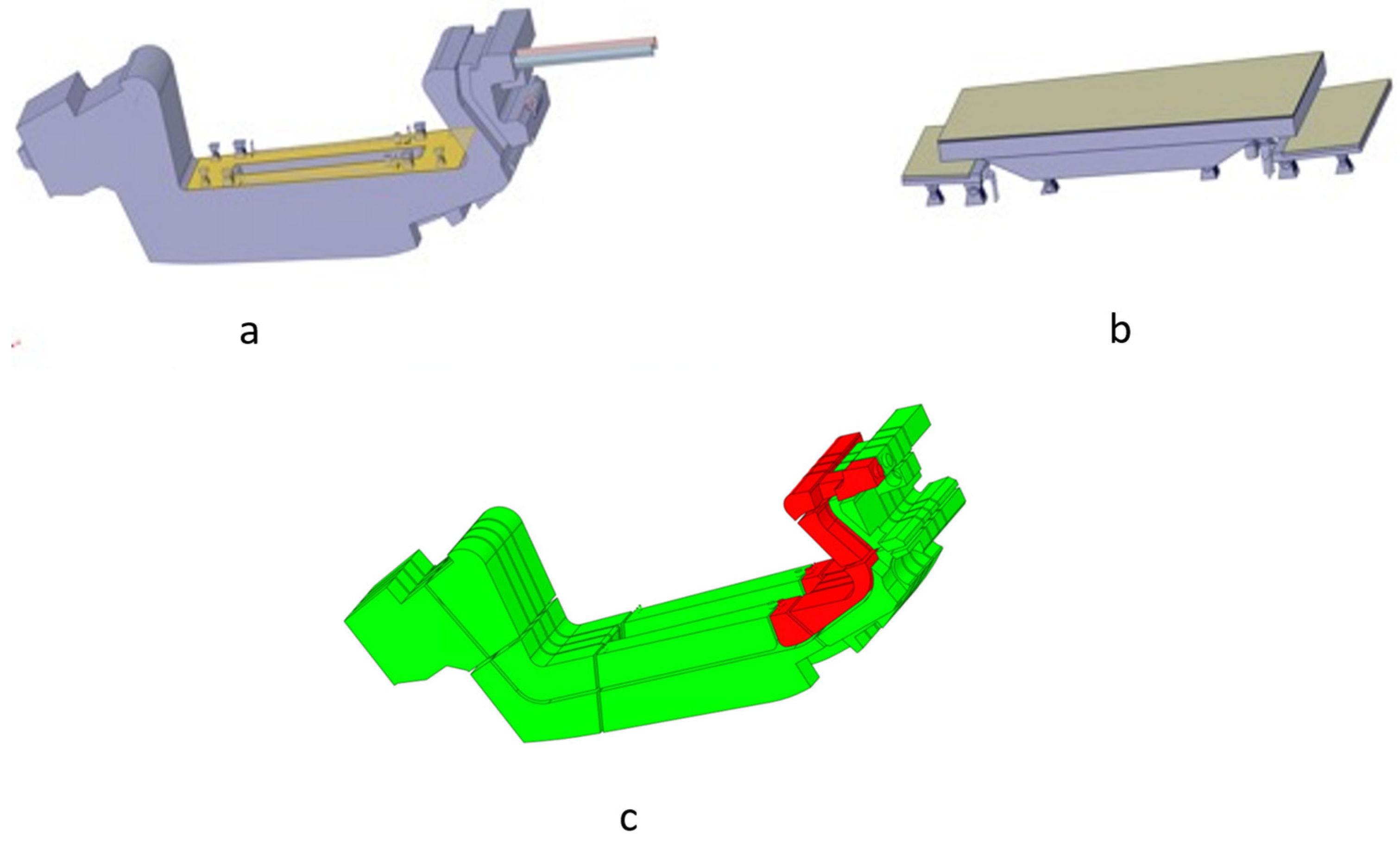
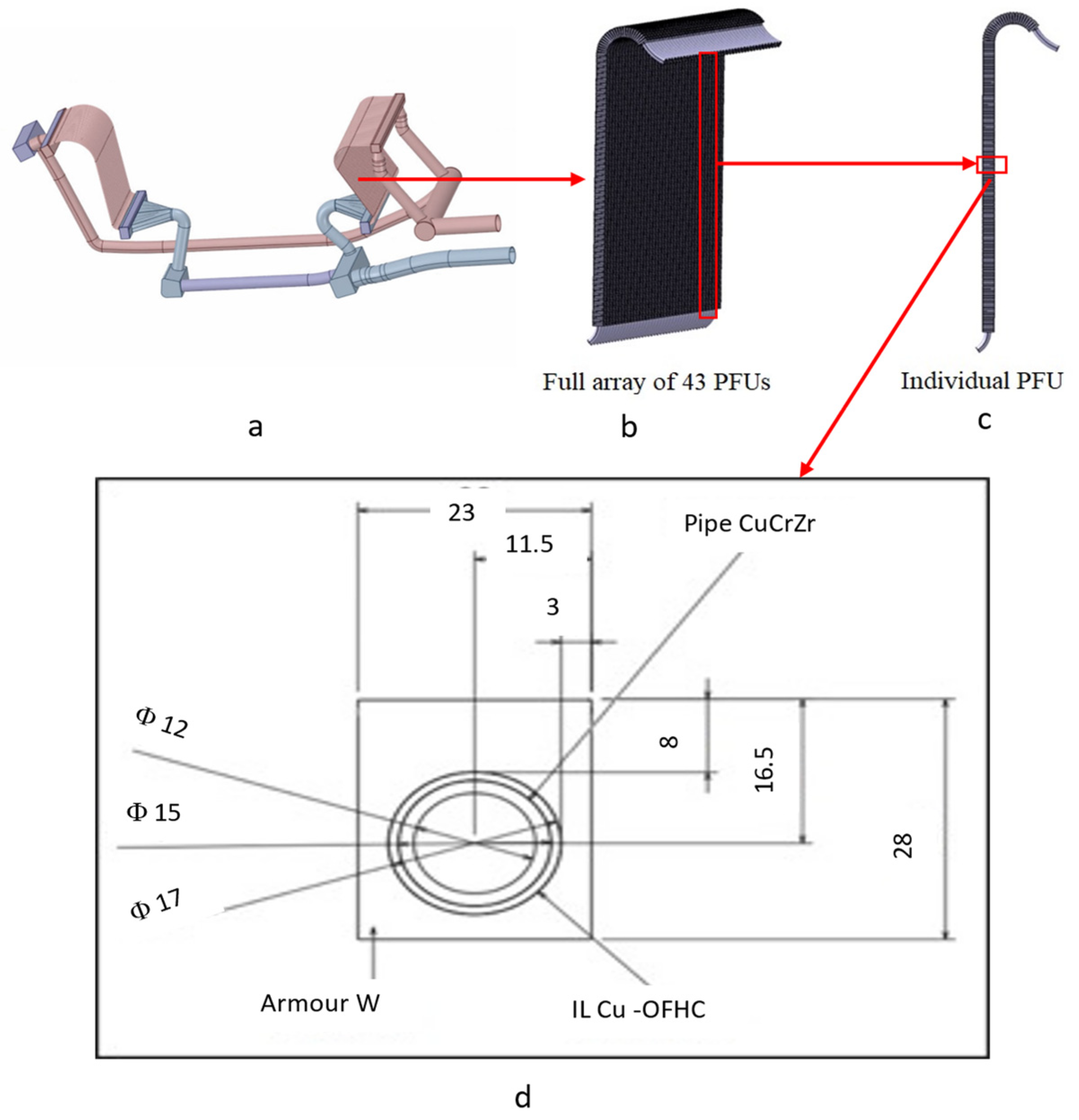

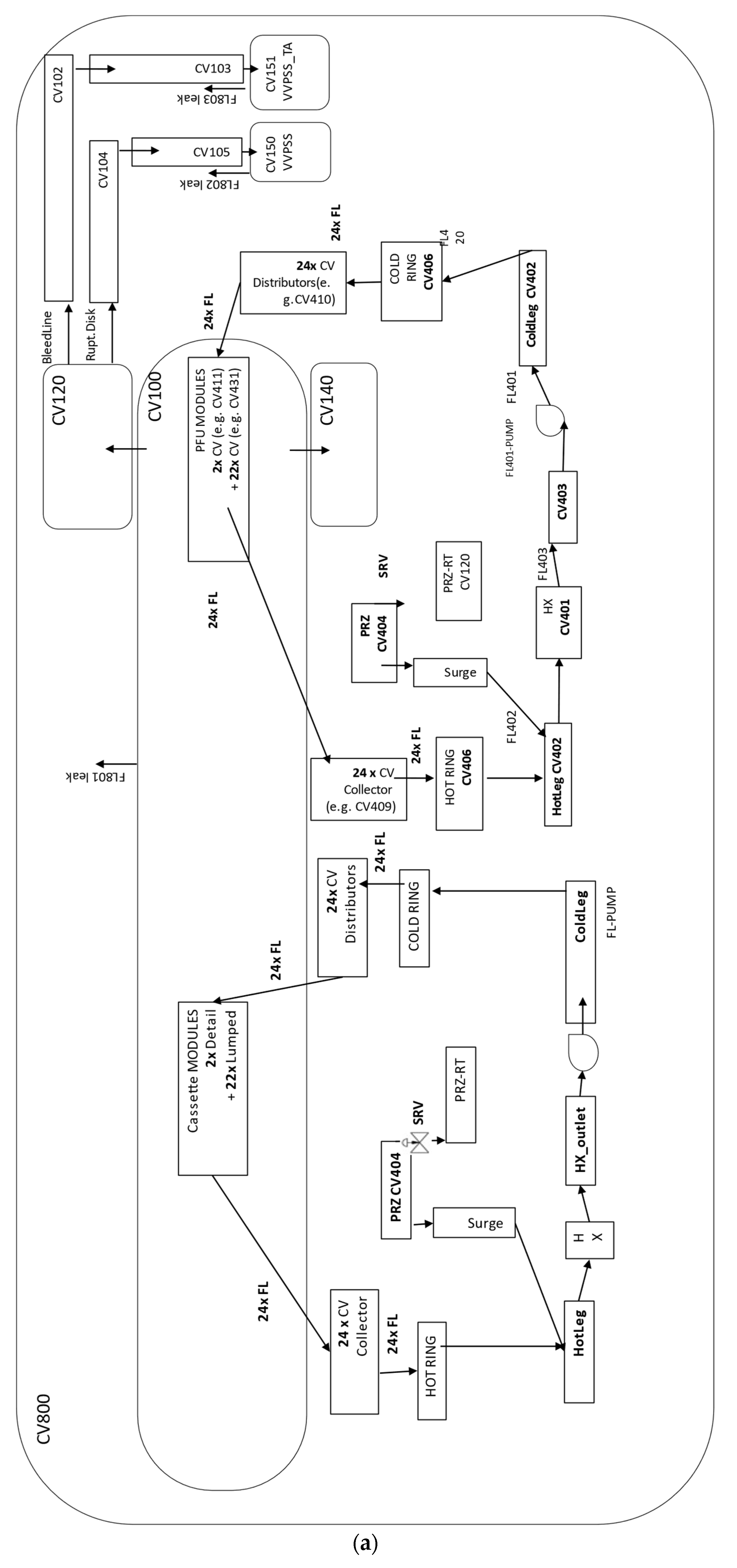

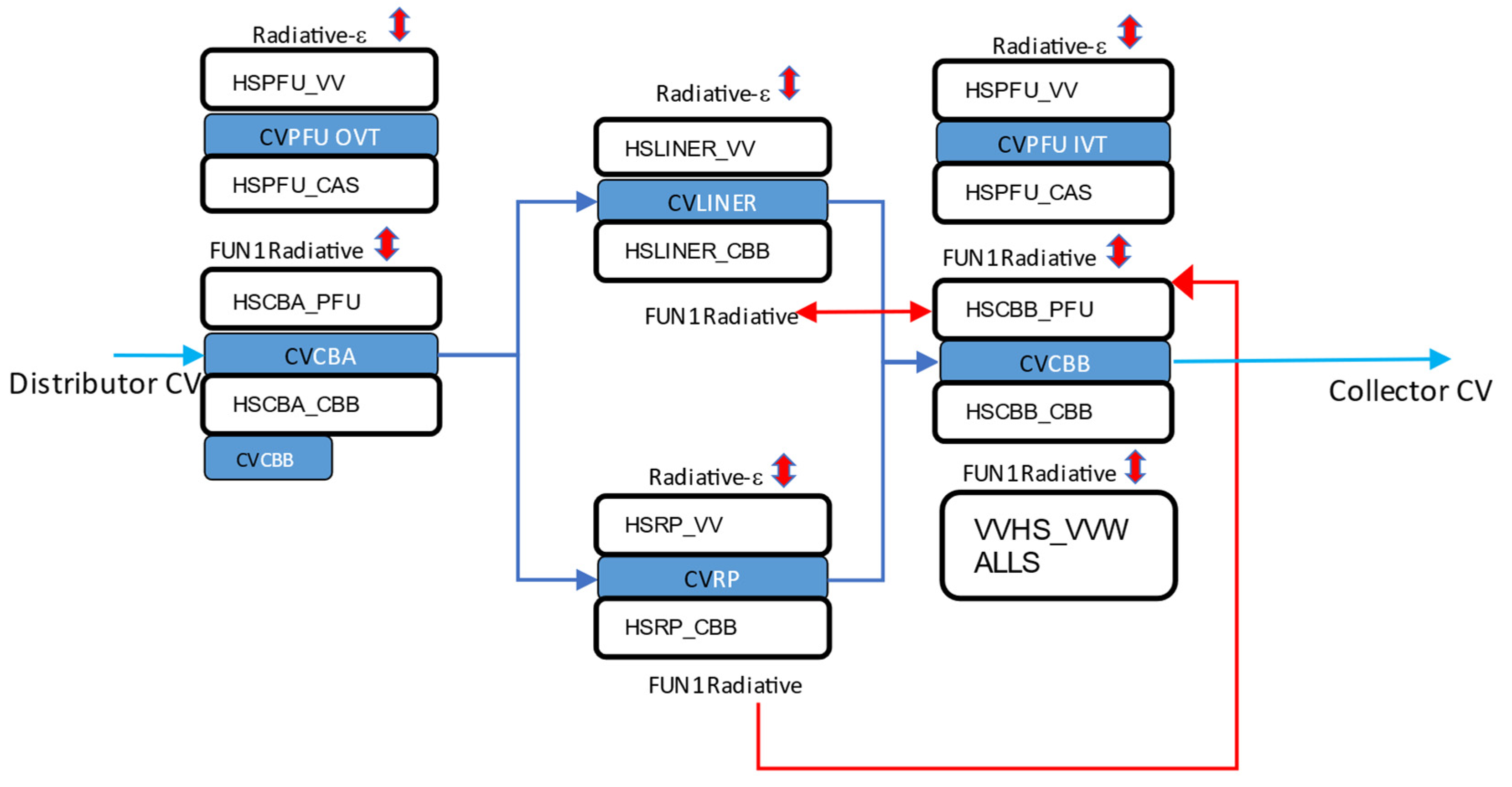
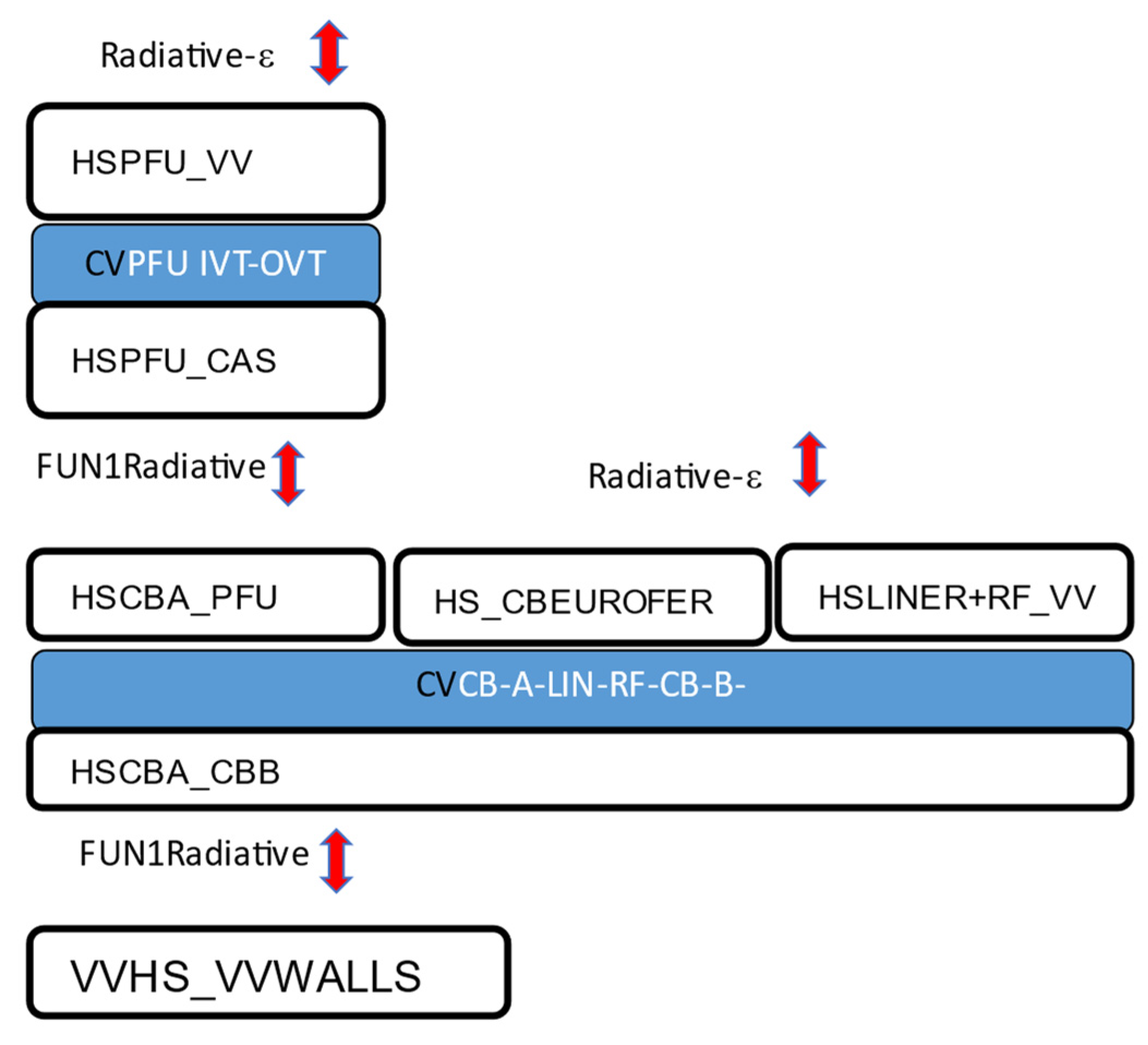

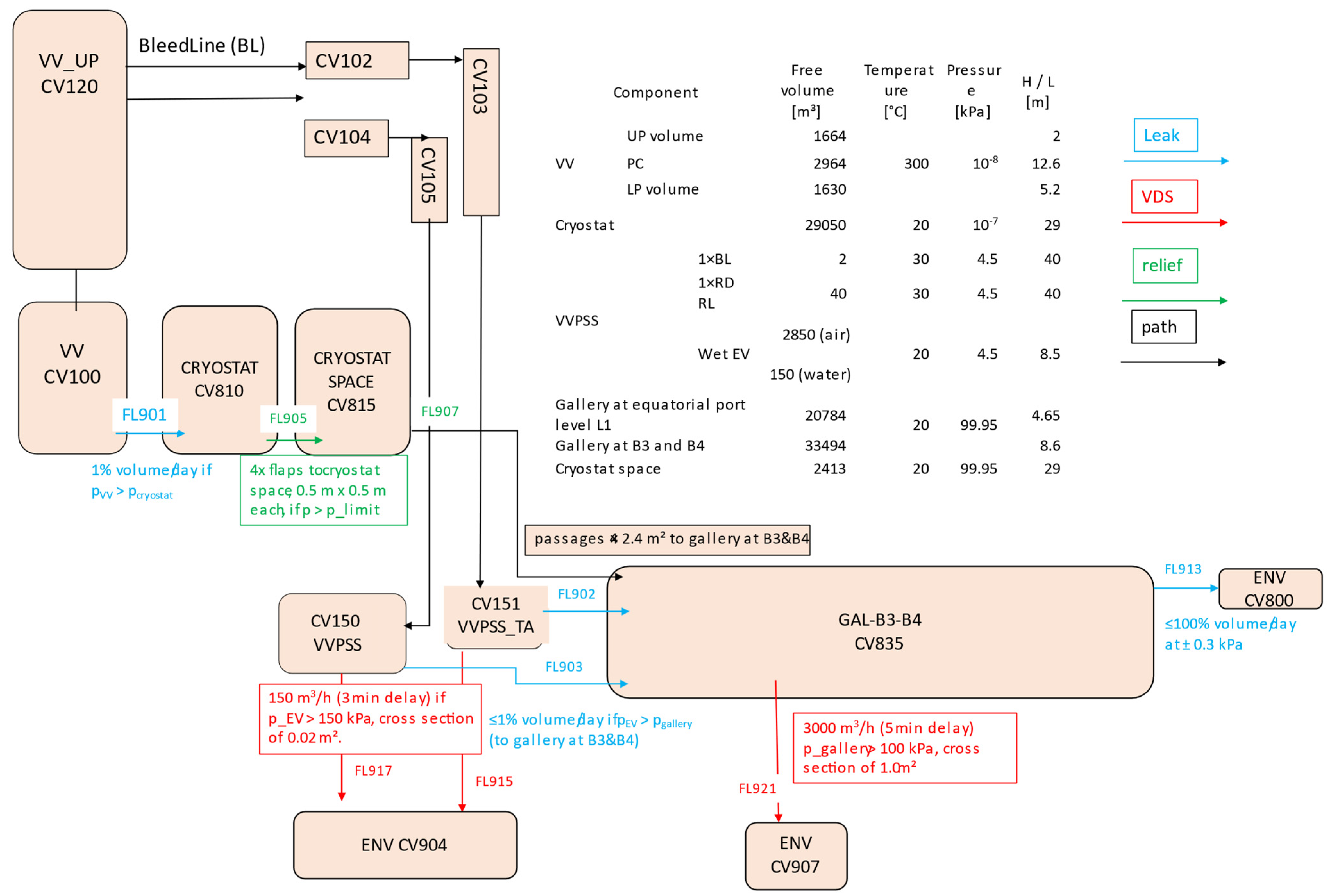




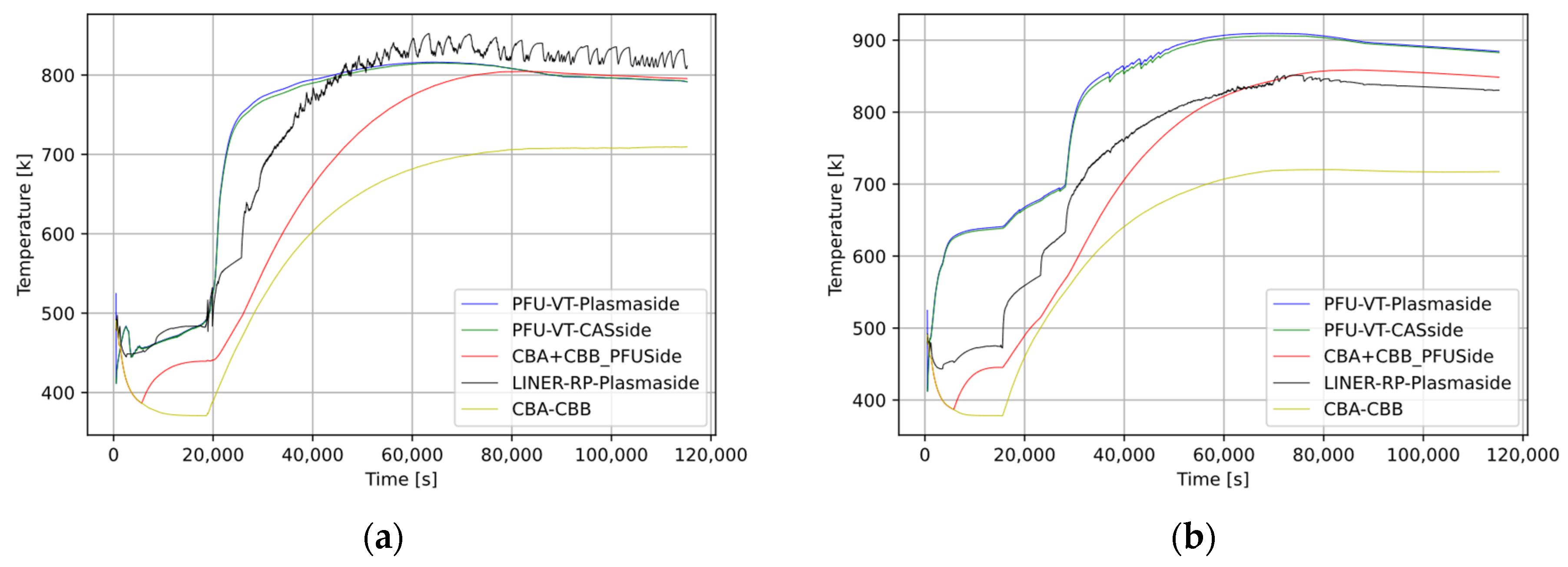




| HTS PFU Loop 24 Units | HTS Cassette Loop 24 Units | |
|---|---|---|
| Loop nominal Thermal Power [MW] | 68 | 57.6 |
| Coolant Tin [°C] | 130 | 180 |
| Coolant Tout [°C] | 136 | 210 |
| Coolant Pin [MPa] | 5 | 3.5 |
| HS TAG | NH [W] | DH 1 s [W] | DH 1 d [W] | DH 1 Week [W] | DH 1 Year [W] |
|---|---|---|---|---|---|
| DIV Cassette (1 module) | 2.37 × 106 | 3.96 × 104 | 8.60 × 103 | 2.56 × 103 | 4.60 × 102 |
| DIV PFU (1 module) | 4.66 × 105 | 1.72 × 104 | 7.73 × 103 | 8.52 × 102 | 5.46 × 101 |
| BB (all modules) | 2.21 × 107 | 1.92 × 107 | 2.26 × 106 | 1.25 × 106 | 2.20 × 105 |
| Variable Description | Target | Simulation | Discrepancy |
|---|---|---|---|
| DIV PFU Inlet Pressure | 5.0 MPa | 4.8 MPa | 4.7% |
| DIV PFU Outlet Pressure | 4.2 MPa | 4.1 MPa | 2.6% |
| DIV Cassette ColdLeg Pressure | 3.5 MPa | 3.7 MPa | 6.5% |
| DIV Cassette HotLeg Pressure | 2.6 MPa | 2.7 MPa | 4.0% |
| PFU Vertical Heat Structure—Plasma Side | 519 K | 520 K | 0.9% |
| PFU Vertical Heat Structure—Cassette Side | 418 K | 418 K | 0.2% |
| CB-A Heat Structure—Plasma Side | 521 K | 519 K | 0.3% |
| CB-A/CB-B Heat Structure—Plasma Side | 511 K | 501 K | 2.1% |
| Cassette Liner and Reflector Heat Structure—Cassette Side | 518 K | 509 K | 1.7% |
| Cassette Liner and Reflector Heat Structure—Plasma Side | 556 K | 536 K | 3.7% |
| Source Terms Type | Volume/Room | Inventory [kg] PIE1 Case | Inventory in Volume [kg] PIE1 Case |
|---|---|---|---|
| HTO | VV + VVUP + VVLP | 3.022 | 3.605 |
| VVPSS/extensions | 14.733 | 14.154 | |
| GalB3B4 | 1.87 × 10 −7 | 1.57 × 10−7 | |
| Cryostat | 1.14 × 10−5 | 1.48 × 10−5 | |
| Tungsten dust | VV + VVUP + VVLP | 407.29 | 277.43 |
| VVPSS/extensions | 435.39 | 684.18 | |
| GalB3B4 | 2.13 × 10−7 | 2.65 × 10−7 | |
| Cryostat | 4.74 × 10−6 | 4.01 × 10−6 | |
| ACP | VV + VVUP + VVLP | 2.11 | 5.419 |
| VVPSS/extensions | - | 1.17 × 10−8 |
Publisher’s Note: MDPI stays neutral with regard to jurisdictional claims in published maps and institutional affiliations. |
© 2022 by the authors. Licensee MDPI, Basel, Switzerland. This article is an open access article distributed under the terms and conditions of the Creative Commons Attribution (CC BY) license (https://creativecommons.org/licenses/by/4.0/).
Share and Cite
Dongiovanni, D.N.; D’Onorio, M.; Caruso, G.; Pinna, T.; Porfiri, M.T. DEMO Divertor Cassette and Plasma facing Unit in Vessel Loss-of-Coolant Accident. Energies 2022, 15, 8879. https://doi.org/10.3390/en15238879
Dongiovanni DN, D’Onorio M, Caruso G, Pinna T, Porfiri MT. DEMO Divertor Cassette and Plasma facing Unit in Vessel Loss-of-Coolant Accident. Energies. 2022; 15(23):8879. https://doi.org/10.3390/en15238879
Chicago/Turabian StyleDongiovanni, Danilo Nicola, Matteo D’Onorio, Gianfranco Caruso, Tonio Pinna, and Maria Teresa Porfiri. 2022. "DEMO Divertor Cassette and Plasma facing Unit in Vessel Loss-of-Coolant Accident" Energies 15, no. 23: 8879. https://doi.org/10.3390/en15238879





